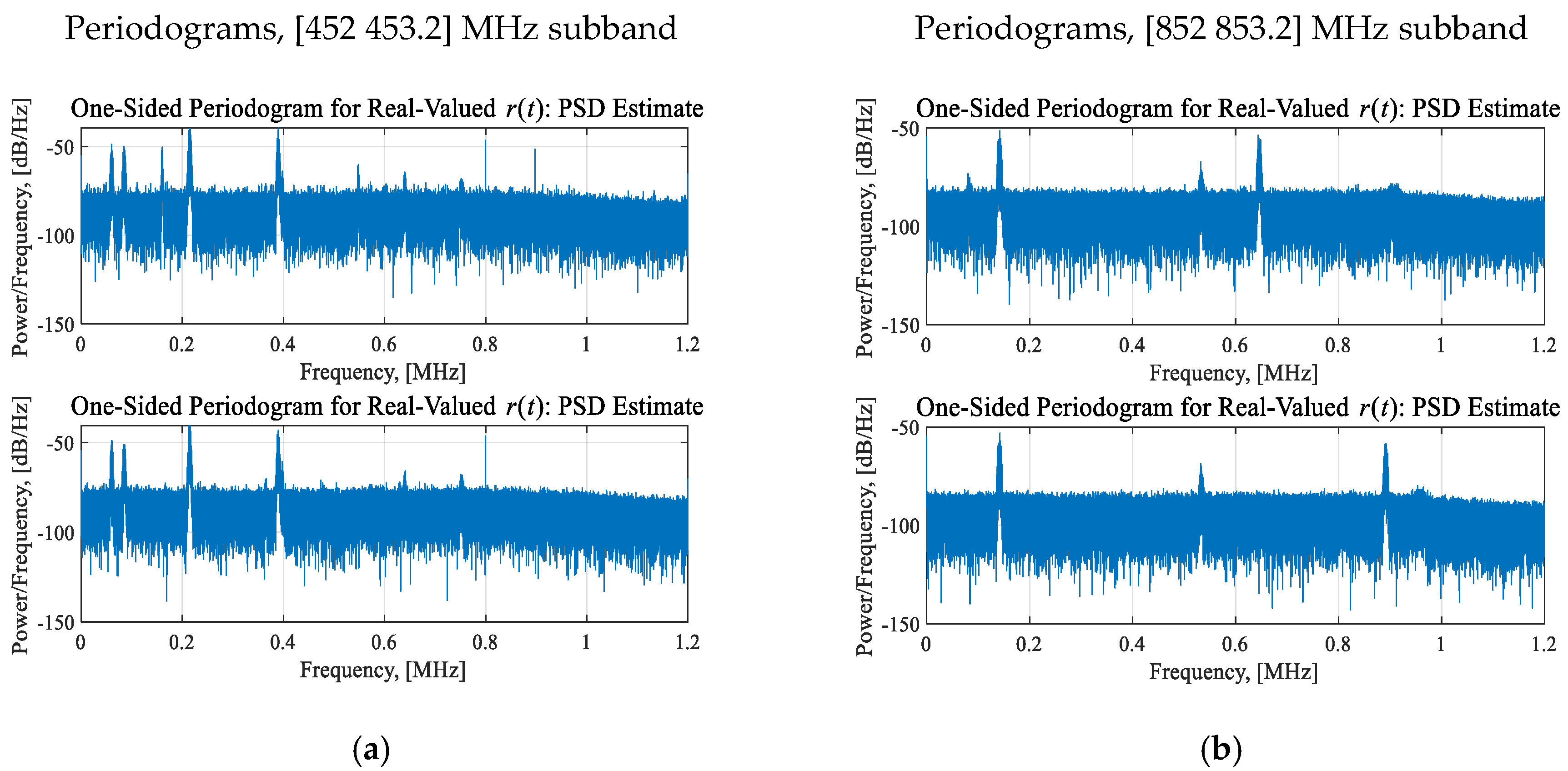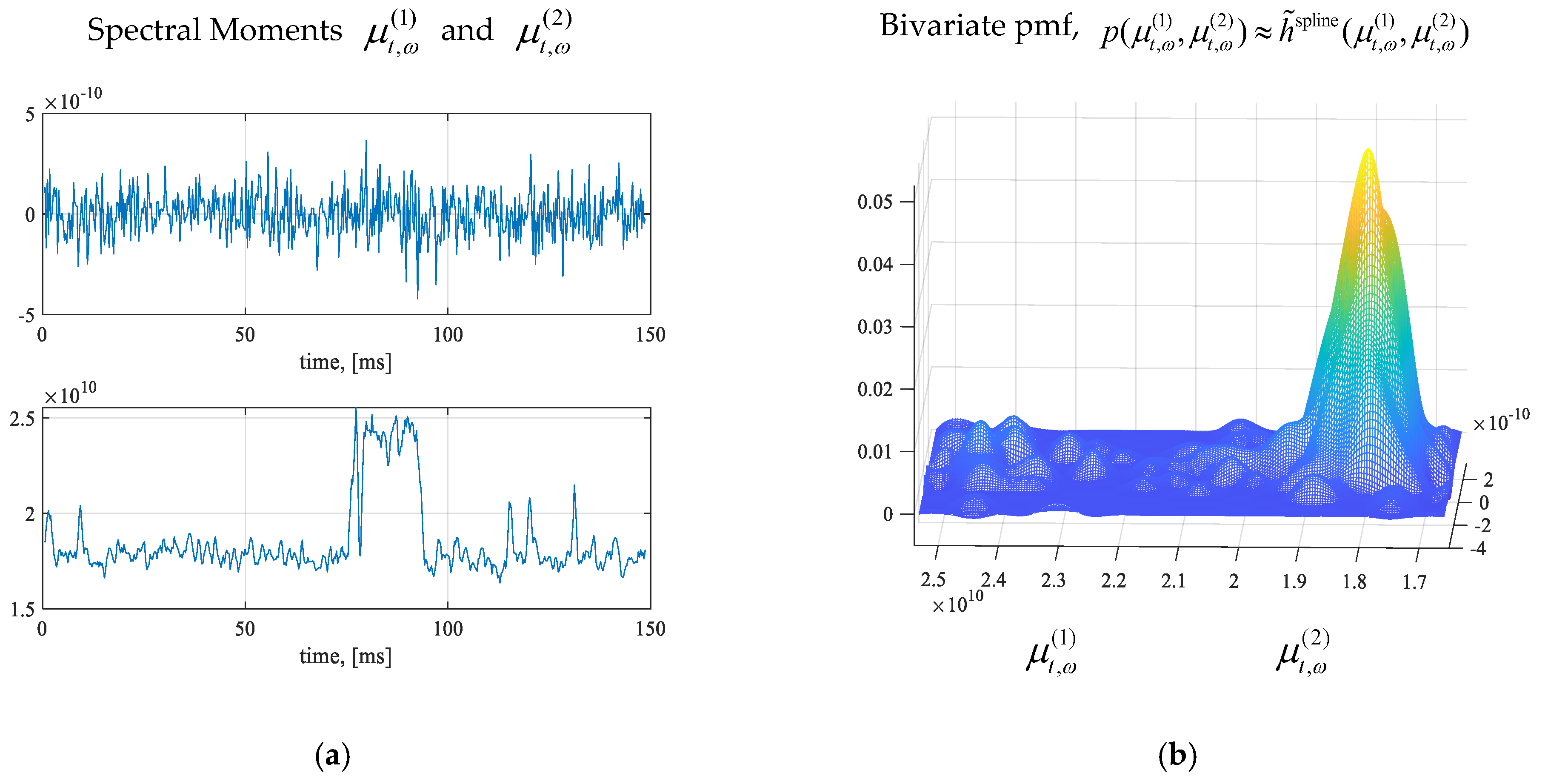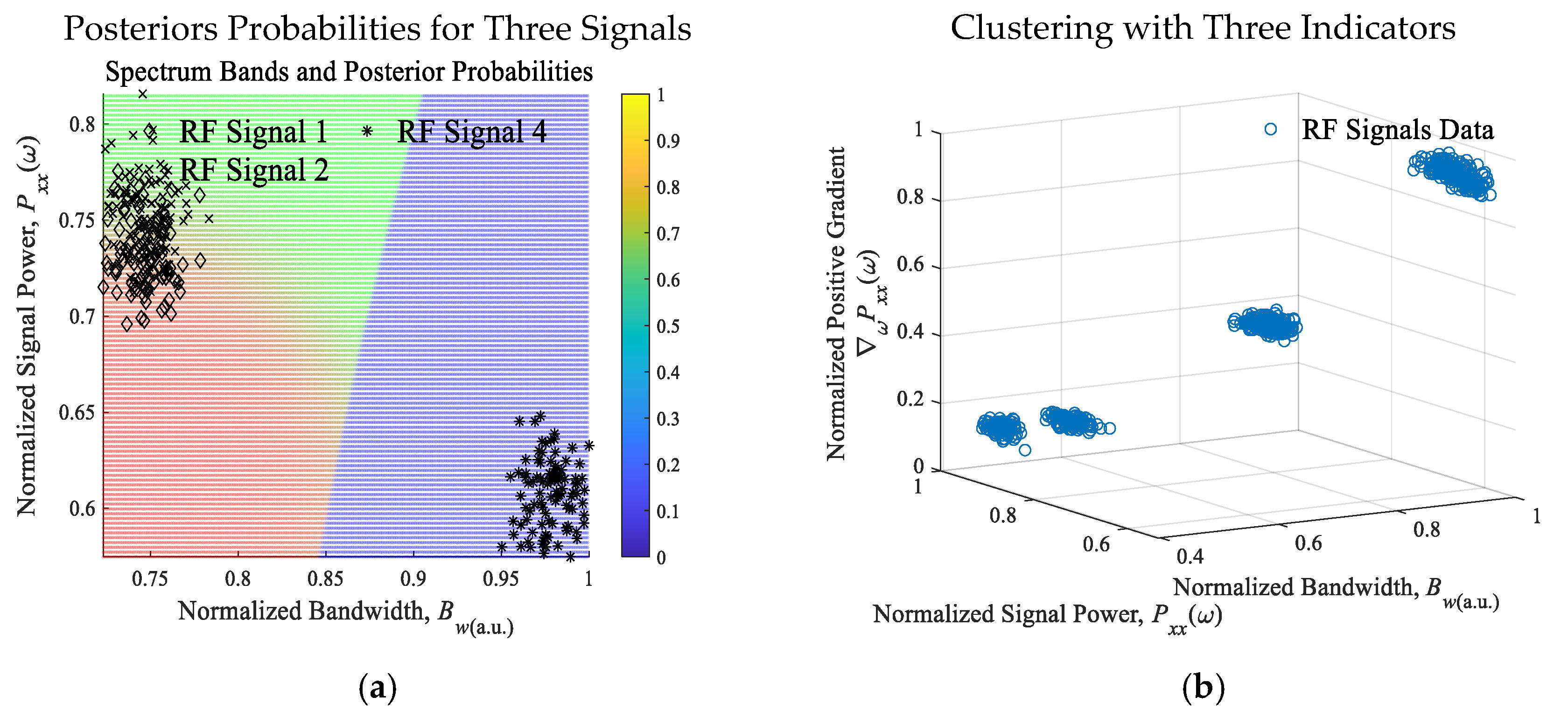Resilient Communication for Software Defined Radio: Machine Reasoning and Electromagnetic Spectrum Evaluation
Abstract
:1. Introduction
2. Radio Frequency Signals in Temporal, Spectral and Probability Domains
2.1. Adaptive Bandpass Filters Design
2.2. Periodogram and Spectrogram
2.3. Statistical Model and Descriptive Statistics
3. Interpretable Machine Reasoning
4. Experimental Studies: Electromagnetic Spectrum and RF Signals Evaluation
- Query ellipse for two features;
- Three-dimensional closed ellipsoid region ,(ai,bi,ci)>0 for the following three features ;
- Ellipsoids in an n-dimension. A quadric hypersurface is , where pi,l are the center coordinates, and, ai,l are the length of the semi-axis.
5. Discussion
6. Conclusions
Author Contributions
Funding
Institutional Review Board Statement
Informed Consent Statement
Data Availability Statement
Acknowledgments
Conflicts of Interest
References
- Cahill, M.T.; Glase, W.E. A channel access protocol for tactical IP networks using software defined VHF radios. In Proceedings of the Military Communications Conference, Anaheim, CA, USA, 7–10 October 2002; Volume 1, pp. 363–368. [Google Scholar] [CrossRef]
- Chamberlain, M.W. A software defined HF radio. In Proceedings of the Military Communications Conference, Atlantic City, NJ, USA, 17–20 October 2005; Volume 4, pp. 2448–2453. [Google Scholar] [CrossRef]
- Nakura, K.; Mori, S.; Masaki, H.; Harada, H. Software-Defined Radio-based IEEE 802.15.4 SUN OFDM evaluation platform for highly mobile environments. IEEE J. Veh. Technol. 2024, 5, 95–107. [Google Scholar] [CrossRef]
- Wang, H.; Crilly, B.; Zhao, W.; Autry, C.; Swank, S. Implementing mobile ad hoc networking (MANET) over legacy tactical radio links. In Proceedings of the Military Communications Conference, Orlando, FL, USA, 29–31 October 2007; pp. 1–7. [Google Scholar] [CrossRef]
- Khaled, H.; Alkhazraji, E. AI optimization-based heterogeneous approach for green next-generation communication systems. Sensors 2024, 24, 4956. [Google Scholar] [CrossRef] [PubMed]
- Wang, G.; Chen, G.; Shen, D.; Tian, X.; Pham, K.; Blasch, E. Spread spectrum design for aeronautical communication system with radio frequency interference. In Proceedings of the Digital Avionics Systems Conference, Prague, Czech Republic, 13–17 September 2015; pp. 2F1-1–2F1-11. [Google Scholar] [CrossRef]
- Romero-Godoy, D.; Molina-Padrón, N.; Cabrera, F.; Araña, V.; Jiménez, E. Design and implementation of a prototype with a low-cost SDR platform for the next generation of maritime communications. In Proceedings of the Atlantic and Asia Pacific Radio Science Meeting, Gran Canaria, Spain, 30 May–4 June 2022; pp. 1–4. [Google Scholar] [CrossRef]
- Wang, Y.; Yang, K.; Ding, J.; Chen, X.; Li, Q.; Peng, T. Design and implementation of Martime 5G communication system based on Software Defined Radio and open air interface. In Proceedings of the Conference on Unmanned Systems, Hefei, China, 13–15 October 2023; pp. 1607–1612. [Google Scholar] [CrossRef]
- Kacpura, T.J.; Downey, J.A.; Anderson, J.R.; Baldwin, K. Evolution of a reconfigurable processing platform for a next generation space Software Defined Radio. In Proceedings of the Aerospace Conference, Big Sky, MT, USA, 1–8 March 2014; pp. 1–10. [Google Scholar] [CrossRef]
- Xiong, W.; Lu, J.; Tian, X.; Chen, G.; Pham, K.; Blasch, E. Cognitive radio testbed for digital beamforming of satellite communication. In Proceedings of the Cognitive Communications for Aerospace Applications Workshop, Cleveland, OH, USA, 27–28 June 2017; pp. 1–5. [Google Scholar] [CrossRef]
- Coronado, E.; Khan, S.N.; Riggio, R. 5G-EmPOWER: A Software-Defined networking platform for 5G radio access networks. IEEE Trans. Netw. Serv. Manag. 2019, 16, 715–728. [Google Scholar] [CrossRef]
- Efstathiou, D.; Fridman, L.; Zvonar, Z. Recent developments in enabling technologies for software defined radio. IEEE Commun. Mag. 1999, 37, 112–117. [Google Scholar] [CrossRef]
- Haghighat, A. A review on essentials and technical challenges of software defined radio. In Proceedings of the Military Communications Conference, Anaheim, CA, USA, 7–10 October 2002; Volume 1, pp. 377–382. [Google Scholar] [CrossRef]
- Hall, P.S.; Gardner, P.; Faraone, A. Antenna requirements for Software Defined and cognitive radios. Proc. IEEE 2012, 100, 2262–2270. [Google Scholar] [CrossRef]
- Mueck, M.; Piipponen, A.; Kalliojärvi, K.; Dimitrakopoulos, G.; Tsagkaris, K.; Demestichas, P.; Casadevall, F.; Pérez-Romero, J.; Sallent, O.; Baldini, G.; et al. ETSI reconfigurable radio systems: Status and future directions on software defined radio and cognitive radio standards. IEEE Commun. Mag. 2010, 48, 78–86. [Google Scholar] [CrossRef]
- Ulversoy, T. Software Defined Radio: Challenges and opportunities. IEEE Commun. Surv. Tutor. 2010, 12, 531–550. [Google Scholar] [CrossRef]
- Jeon, H.-B.; Kim, S.-M.; Moon, H.-J.; Kwon, D.-H.; Lee, J.-W.; Chung, J.-M. Free-space optical communications for 6G wireless networks: Challenges, opportunities, and prototype validation. IEEE Commun. Mag. 2023, 61, 116–121. [Google Scholar] [CrossRef]
- Karle, C.; Neu, M.; Nuss, B.; Chen, J.; Witte, L.; Scheder, A.; Harbaum, T.; Becker, J. Modular hardware design for high-performance MIMO-capable SDR systems to accelerate 6G development. In Proceedings of the System-on-Chip Conference, Dresden, Germany, 16–19 September 2024; pp. 1–6. [Google Scholar] [CrossRef]
- DoD Announces Release of JADC2 Implementation Plan; U.S. Department of Defense: Arlington County, VA, USA, 2022.
- Hou, Y.T.; Shi, Y.; Sherali, H.D. Optimal spectrum sharing for multi-hop Software Defined Radio networks. In Proceedings of the Conference Computer Communications, Anchorage, AK, USA, 6–12 May 2007; pp. 1–9. [Google Scholar] [CrossRef]
- Ru, Z.; Moseley, N.A.; Klumperink, E.A.M.; Nauta, B. Digitally enhanced Software-Defined Radio receiver robust to out-of-band interference. IEEE J. Solid-State Circuits 2009, 44, 3359–3375. [Google Scholar] [CrossRef]
- Satapathy, J.R.; Bodade, R.M.; Ayeelyan, J. Framework for intelligent radio grid for legacy radio sets using CNN based signal classifier and Software Defined Radios. In Proceedings of the Global Power, Energy and Communication Conference, Budapest, Hungary, 4–7 June 2024; pp. 759–764. [Google Scholar] [CrossRef]
- Soltani, S.; Sagduyu, Y.E.; Hasan, R.; Davaslioglu, K.; Deng, H.; Erpek, T. Real-time and embedded deep learning on FPGA for RF signal classification. In Proceedings of the Military Communications Conference, Norfolk, VA, USA, 12–14 November 2019; pp. 1–6. [Google Scholar] [CrossRef]
- Yakkati, R.R.; Yakkati, R.R.; Tripathy, R.K.; Cenkeramaddi, L.R. Radio Frequency Spectrum Sensing by Automatic Modulation Classification in Cognitive Radio System Using Multiscale Deep CNN. IEEE Sens. J. 2022, 22, 926–938. [Google Scholar] [CrossRef]
- Yeh, H.-G.; Farthing, G.D. GPS L1 C/A spoof detection through the application of deep neural networks. In Proceedings of the Conference Parallel and Distributed Processing with Applications, Big Data and Cloud Computing, Sustainable Computing and Communications, Social Computing and Networking, Wuhan, China, 21–24 December 2023; pp. 1129–1134. [Google Scholar] [CrossRef]
- Li, Y.; Pawlak, J.; Price, J.; Al Shamaileh, K.; Niyaz, Q. Jamming Detection and Classification in OFDM-Based UAVs via Feature- and Spectrogram-Tailored Machine Learning. IEEE Access 2022, 10, 16859–16870. [Google Scholar] [CrossRef]
- Roy, D.; Mukherjee, T.; Chatterjee, M.; Blasch, E.; Pasiliao, E. RFAL: Adversarial learning for RF transmitter identification and classification. IEEE Trans. Cogn. Commun. Netw. 2020, 6, 783–801. [Google Scholar] [CrossRef]
- Engelhardt, M.; Giehl, S.; Schubert, M.; Ihlow, A.; Schneider, C.; Ebert, A.; Landmann, M.; Del Galdo, G.; Andrich, C. Accelerating Innovation in 6G Research: Real-Time Capable SDR System Architecture for Rapid Prototyping. IEEE Access 2024, 12, 118718–118732. [Google Scholar] [CrossRef]
- Pandeya, N.; Haj-Omar, A.; Dhananjay, A.; Zappe, M. 5G ORAN O-RU Emulator Implemented on the USRP SDR in the FR1 and FR3 Bands. In Proceedings of the MILCOM 2024—2024 IEEE Military Communications Conference (MILCOM), Washington, DC, USA, 28 October–1 November 2024; pp. 684–685. [Google Scholar] [CrossRef]
- Hasan, M.N.; Gu, Q.J.; Liu, X. Tunable blocker-tolerant on-chip radio-frequency front-end filter with dual adaptive transmission zeros for Software-Defined Radio applications. IEEE Trans. Microw. Theory Tech. 2016, 64, 4419–4433. [Google Scholar] [CrossRef]
- Hashimoto, K.-Y.; Tanaka, S.; Esashi, M. Tunable RF SAW/BAW filters: Dream or reality? In Proceedings of the Conference Frequency Control and the European Frequency and Time Forum, San Francisco, CA, USA, 2–5 May 2011; pp. 1–8. [Google Scholar] [CrossRef]
- Shakibafar, B.; Farhangian, F.; Gagne, J.-M.; Landry, R., Jr.; Nabki, F. An adaptive RF front-end architecture for multi-band SDR in avionics. Sensors 2024, 24, 5963. [Google Scholar] [CrossRef]
- Xu, Y.; Amineh, R.K.; Dong, Z.; Li, F.; Kirton, K.; Kohler, M. Software Defined Radio-based wireless sensing system. Sensors 2022, 22, 6455. [Google Scholar] [CrossRef]
- Kamp, Y.; Wellekens, C. Optimal design of minimum-phase FIR filters. IEEE Trans. Acoust. Speech Signal Process. 1983, 31, 922–926. [Google Scholar] [CrossRef]
- Karam, L.J.; McClellan, J.H. Complex Chebyshev approximation for FIR filter design. IEEE Trans. Circuits Syst. II Analog. Digit. Signal Process. 1995, 42, 207–216. [Google Scholar] [CrossRef]
- McClellan, J.H.; Parks, T.W. A personal history of the Parks-McClellan algorithm. IEEE Signal Process. Mag. 2005, 22, 82–86. [Google Scholar] [CrossRef]
- Lyshevski, S.E. Control of Physical and Cyber-Physical Systems; CRC Press: Boca Raton, FL, USA, 2024. [Google Scholar]
- Lyshevski, S.E. Signal processing in cyber-physical MEMS sensors: Inertial measurement and navigation systems. IEEE Trans. Ind. Electron. 2017, 64, 9618–9625. [Google Scholar] [CrossRef]
- Harel, D.; Kozen, D.; Tiuryn, J. Dynamic Logic; MIT Press: Cambridge, MA, USA, 2000. [Google Scholar]
- Welch, P.D. The use of fast Fourier transform for the estimation of power spectra: A method based on time averaging over short, modified periodograms. IEEE Trans. Audio Electroacoust. 1967, 15, 70–73. [Google Scholar] [CrossRef]
- Spooner, C.M.; Gardner, W.A. The cumulant theory of cyclostationary time-series, Part II: Development and applications. IEEE Tran. Signal Process. 1994, 42, 3409–3429. [Google Scholar] [CrossRef]





| Attributes | Features: Domain-Specific Quantitative Characteristics, Transforms and Operators on Attributes and Metrics |
|---|---|
| 1. RF signals modulation and polarization. | 1. Computed spectrum characteristics, periodograms, spectrograms, PSD, gradient estimates, etc. |
| 2. Bands, wavelength, center frequency fc and bandwidth Bw. | 2. Temporal and probabilistic characteristics on (fc,Bw), including statistical regularity. |
| 3. Signal (carrier, noise, interference and jamming) strength, power spectral density, signal-to-noise ratio, etc. | 3. Temporal, spectral and probabilistic characteristics, such as: Finite-dimensional transforms, distributions, pmf, cdf, variance, correlation, spectral moments, etc. |
| RF Signals, (fc, Sxx, Bw) | |
|---|---|
| 1 | fc = 452.0602 MHz, Sxx = −48.58 dB/Hz, Bw = 9.4 kHz. |
| 2 | fc = 452.0846 MHz, Sxx = −49.75 dB/Hz, Bw = 9.4 kHz. |
| 3 | fc = 452.1604 MHz, Sxx = −50.23 dB/Hz, Bw = 5.3 kHz. |
| 4 | fc = 452.2154 MHz, Sxx = −39.74 dB/Hz, Bw = 12.3 kHz. |
| 5 | fc = 452.3907 MHz, Sxx = −39.38 dB/Hz, Bw = 11.7 kHz. |
| 6 | fc = 452.3983 MHz, Sxx = −63.84 dB/Hz, Bw = 5.9 kHz. |
Disclaimer/Publisher’s Note: The statements, opinions and data contained in all publications are solely those of the individual author(s) and contributor(s) and not of MDPI and/or the editor(s). MDPI and/or the editor(s) disclaim responsibility for any injury to people or property resulting from any ideas, methods, instructions or products referred to in the content. |
© 2025 by the authors. Licensee MDPI, Basel, Switzerland. This article is an open access article distributed under the terms and conditions of the Creative Commons Attribution (CC BY) license (https://creativecommons.org/licenses/by/4.0/).
Share and Cite
Lyshevski, S.E.; Buckley, R.; Feuerstein, C. Resilient Communication for Software Defined Radio: Machine Reasoning and Electromagnetic Spectrum Evaluation. Sensors 2025, 25, 1826. https://doi.org/10.3390/s25061826
Lyshevski SE, Buckley R, Feuerstein C. Resilient Communication for Software Defined Radio: Machine Reasoning and Electromagnetic Spectrum Evaluation. Sensors. 2025; 25(6):1826. https://doi.org/10.3390/s25061826
Chicago/Turabian StyleLyshevski, Sergey Edward, Richard Buckley, and Christopher Feuerstein. 2025. "Resilient Communication for Software Defined Radio: Machine Reasoning and Electromagnetic Spectrum Evaluation" Sensors 25, no. 6: 1826. https://doi.org/10.3390/s25061826
APA StyleLyshevski, S. E., Buckley, R., & Feuerstein, C. (2025). Resilient Communication for Software Defined Radio: Machine Reasoning and Electromagnetic Spectrum Evaluation. Sensors, 25(6), 1826. https://doi.org/10.3390/s25061826






